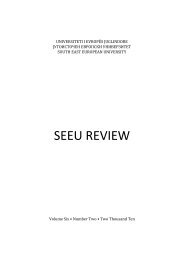SEEU Review vol. 5 Nr. 2 (pdf) - South East European University
SEEU Review vol. 5 Nr. 2 (pdf) - South East European University
SEEU Review vol. 5 Nr. 2 (pdf) - South East European University
You also want an ePaper? Increase the reach of your titles
YUMPU automatically turns print PDFs into web optimized ePapers that Google loves.
<strong>SEEU</strong> <strong>Review</strong> Volume 5, No. 2, 2009<br />
and therefore liberty can be restricted only for the sake of liberty”. Second<br />
Priority Rule suggests the priority of justice over efficiency and welfare:<br />
“The second principle of justice is lexically prior to the principle of<br />
efficiency and to that of maximizing the sum of advantages; and fair<br />
opportunity is prior to the difference principle”. General Conception refers<br />
to basic social goods and values: “All social primary goods - liberty and<br />
opportunity, income and wealth, and the bases of self-respect - are to be<br />
distributed equally unless an unequal distribution of any or all of these goods<br />
is to the advantage of the least favored” (Rawls, 1971, 302-3).<br />
General conception of justice is suggested in TJ’s previous pages as<br />
follows:<br />
“All social values - liberty and opportunity, income and wealth, and the<br />
bases of self-respect - are to be distributed equally unless an unequal<br />
distribution of any, or all, of these values is to everyone’s advantage”.<br />
In addition, injustice is seen as “simply inequalities that are not to the<br />
benefit of all”. This general conception “imposes no restrictions on what sort<br />
of inequalities are permissible; it only requires that everyone’s position be<br />
improved” (Rawls, 1971, 62).<br />
Priority rules and general conception of justice seem to be suggested as<br />
security valves for liberal democratic society. However, we are still at the<br />
stage of principles built and constructed by Rawls himself only.<br />
Rawls gives the priority to the liberty in the first principle and excludes it<br />
in the second principle. This exclusion is believed as Rawls’ contribution to<br />
the theory of distributive justice while the first principle is considered as the<br />
distinctive contribution to the traditional tension between justice and liberty.<br />
If we reach at the social minimum of material wealth, we do not exchange<br />
liberty for any other social goods. However, liberty can be restricted only in<br />
favour of liberty. Here criteria of restriction are the principle of common<br />
good or common interest in that all can agree that no restriction will be<br />
harmful for all. However, possibility of such an agreement is controversial<br />
and even absent (said by Scanlon), the principle of common interest is<br />
problematic because of the difficulty in balancing the competing liberties,<br />
and the relative importance of the liberties that are different in terms of<br />
advantages and disadvantages embodied in the liberties. This argument is<br />
developed much more in the Marxist critics (Daniels, 1978, xxvi-ii).<br />
Furthermore, a communitarian attack followed traditional criticism of<br />
excessive individualism of liberalism and claimed that background<br />
23

















